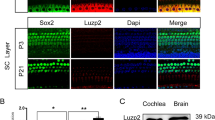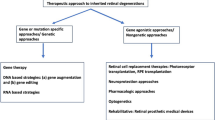Abstract
Rod photoreceptor cGMP phosphodiesterase (PDE6) is a three-subunit (a, b, g2) enzyme that functions to reduce intracellular cytoplasmic cGMP levels, an integral feature of the phototransduction cascade of vision. To allow assessment of the potential for defects in the gene encoding the α-subunit (PDE6A) to cause visual dysfunction, and to begin to dissect the basis for photoreceptor-specific expression of this gene, we have characterized the structural gene and upstream region. The human PDE6A gene consists of 22 exons spanning about 60 kb with the intron/exon junctions highly conserved in comparison to the mouse and human PDE6B genes. Using ribonuclease protection and primer extension assays, a predominant transcription start point (tsp) was identified 120 bp upstream of the initiator ATG. To begin functional analysis of the PDE6A promoter, approx 4 kb of sequence were determined upstream of the tsp. Comparison of this upstream sequence with an ∼500 bp sequence upstream of the mousePde6a gene revealed five distinct segments of identity all within 100 bp upstream of the human PDE6A tsp. A TATA box adjacent to a photoreceptor-specific RET1-like binding site, an SP1 site, and two novel putativecis-element sequences were found. A consensus initiator element sequence is present at the tsp. Additionally, within a 2.5-kb segment beginning 900 bp upstream of the tsp two Alu, a MIR, an L1, and two MER repetitive elements were found. Electrophoretic mobility shift assays generate a retina-specific bandshift using a 322-bp fragment containing the putative promoter region or a multimer of the RET1-like site. DNA footprinting assays revealed foot-prints over the primary transcription startpoint and the RET1-like and TATA box regions. These results indicate that a 220-bp segment of the PDE6A gene upstream region is important for tissue-specific expression.
Similar content being viewed by others
Abbreviations
- PDE6:
-
photoreceptor-specific family of 3′-5′ cyclic nucleotide phosphodiesterases
- PDE6A:
-
locus encoding human rod photoreceptor cGMP phosphodiesterase α-subunit gene
- PDE6B:
-
locus encoding human rod photoreceptor cGMP phosphodiesterase β-subunit gene
- PCR:
-
polymerase chain reaction
- RACE:
-
rapid amplification of cDNA ends
- tsp:
-
transcription start point
- RET1/PCE1:
-
cis-element found in the upstream region of many photoreceptor-specific genes
References
Anant J. S., Ong O. C., Xie H., Clarke S., O’Brien P. J., and Fung B. K. K. (1992) In vivo differential prenylation of retinal cyclic GMP phosphodiesterase catalytic subunits.J. Biol. Chem. 267, 687–690.
Arranz V., Kress M., and Ernoult-Lange M. (1994) The gene encoding the MOK-2 zinc-finger protein: characterization of its promoter and negative regulation by mouse Alu type-2 repetitive elements.Gene 149, 293–298.
Baehr W., Champagne M. S., Lee A. K., and Pittler S. J. (1991) Complete cDNA sequences of mouse rod photoreceptor cGMP phosphodiesterase alpha and beta subunits, and identification of beta’, a putative beta subunit isozyme produced by alternative splicing of the beta subunit gene.FEBS Lett. 278, 107–114.
Bahring S., Volker S., Lieber A., and Strauss M. (1994) Mapping of transcriptional start and capping points by a modified 5′RACE technique.BioTechniques 16, 807,808.
Batni S., Scalzetti L., Moody S. A. and Knox B. E. (1996) Characterization of theXenopus rhodopsin gene.J. Biol. Chem. 271, 3179–3186.
Breitman M. L., Tsuda M., Usukura J., Kikuchi T., Zucconi A., Khoo W., et al. (1991) Expression of s-antigen in retina, pineal gland, lens, and brain is directed by 5′flanking sequences.J. Biol. Chem. 266, 15,505–15,510.
Brini A. T., Lee G. M., and Kinet J. P. (1993) Involvement of Alu sequences in the cell-specific regulation of transcription of the gamma chain of Fc and T cell receptors.J. Biol. Chem. 268, 1355–1361.
Britten R. J. (1994) Evidence that most human Alu sequences were inserted in a process that ceased about 30 million years ago.Proc. Natl. Acad. Sci. USA 91, 6148–6150.
Chen S. and Zack D. J. (1996) Ret 4, a positive acting rhodopsin regulatory element identified using a bovine retina in vitro transcription system.J. Biol. Chem. 271, 28,549–28,557.
Chen S., Wang Q. L., Nie Z., Sun H., Lennon G., Copeland N. G., et al. (1997) Crx, a novel Otx-like paired-homeodomain protein, binds to and transactivates photoreceptor cell-specific genes.Neuron 19, 1017–1030.
Demarzo A. M., Beck C. A., Onate S. A., and Edwards D. P. (1991) Dimerization of mammalian progesterone receptors occurs in the absence of DNA and is related to the release of the 90-kDa heat shock protein.Proc. Natl. Acad. Sci. USA 88, 72–76.
DesJardin L. E. and Hauswirth W. W. (1996) Developmentally important DNA elements within the bovine opsin upstream region.Invest. Ophthalmol. Vis. Sci. 37, 154–165.
Deterre P., Bigay J., Forquet F., Robert M., and Chabre M. (1988) cGMP phosphodiesterase of retinal rods is regulated by two inhibitory subunits.Proc. Natl. Acad. Sci. USA 85, 2424–2428.
DiPolo P. A. and Farber D. B. (1995) Rod photoreceptor-specific gene expression in human retinoblastoma cells.Proc. Natl. Acad. Sci. USA 92, 4016–4020.
DiPolo P. A., Lerner L. E., and Farber D. B. (1997) Transcriptional activation of the human rod cGMP-phosphodiesterase beta- subunit gene is mediated by an upstream AP-1 element.Nucleic Acids. Res. 25, 3863–3867.
DiPolo P. A., Rickman C. B., and Farber D. B. (1996) Isolation and initial characterization of the 5′ flanking region of the human and murine cyclic guanosine monophosphate-phosphodiesterase beta-subunit genes.Invest. Ophthalmol. Vis. Sci. 37, 551–560.
Fei Y., Matragoon S., and Liou G. I. (1995) Simple and efficient method for the preparation of nuclear extracts.BioTechniques 18, 984–987.
Fortini M. E. and Rubin G. M. (1990) Analysis ofcis-acting requirements of theRh3 andRh4 genes reveals a bipartite organization to rhodopsin promoters inDrosophila melanogaster.Genes Dev. 4, 444–463.
Fung B. K. K., Young J. H., Yamane H. K., and Griswold-Prenner I. (1990) Subunit stoichiometry of retinal rod cGMP phosphodiesterase.Biochemistry 29, 2657–2664.
Furukawa T., Morrow E. M., and Cepko C. L. (1997) Crx, a novel otx-like homeobox gene, shows photoreceptor-specific expression and regulates photoreceptor differentiation.Cell 91, 531–541.
Harvey R. J. and Darlison M. G. (1991) Randomprimed cDNA synthesis facilitates the isolation of multiple 5′-cDNA ends by RACE.Nucleic Acids Res. 19, 4002.
Hauswirth W. W., Langerijt A. V. D., Timmers A. M., Adamus G., and Ulshafer R. J. (1992) Early expression and localization of rhodopsin and interphotoreceptor retinoid-binding protein (IRBP) in the developing fetal bovine retina.Exp. Eye Res. 54, 661–670.
Huang S. H., Pittler S. J., Huang X., Oliveira L., Berson E. L., and Dryja T. P. (1995) Autosomal recessive retinitis pigmentosa caused by mutations in the α subunit of rod cGMP phosphodiesterase.Nature Genet. 11, 468–471.
Jurka J., Walichiewicz J., and Milosavljevic A. (1992) Prototypic sequences for human repetitive DNA.J. Mol. Evol. 35, 286–291.
Kikuchi T., Raju K., Breitman M. L., and Shinohara T. (1993) The proximal promoter of the mouse arrestin gene directs gene expression in photoreceptor cells and contains an evolutionarily conserved retinal factor-binding site.Mol. Cell Biol. 13, 4400–4408.
Kraus R. J., Murray E. E., Wiley S. R., Zink N. M., Loritz K., Gelembiuk G. W., et al. (1996) Experimentally determined weight matrix definitions of the initiator and TBP binding site elements of promoters.Nucleic Acids. Res. 24, 1531–1539.
Lem J., Applebury M. L., Falk J. D., Flannery J. G., and Simon M. I. (1991) Tissue-specific and developmental regulation of rod opsin chimeric genes in transgenic mice.Neuron 6, 201–210.
Liou G. I., Geng L., Al-Ubaidi M. R., Matragoon S., Hanten G., Baehr W., et al. (1990) Tissue-specific expression in transgenic mice directed by the 5′-flanking sequences of the human gene encoding interphotoreceptor retinoid-binding protein.J. Biol. Chem. 265, 8373–8376.
Lo K. and Smale S. T. (1996) Generality of a functional initiator consensus sequence.Gene 182, 13–22.
Meins M., Janecke A., Marschke, C., Denton M. J., Kumaramanickavel K. G., Pittler S. J., et al. (1997) Mutations in PDE6A, the gene encoding the α-subunit of rod photoreceptor cGMP-specific phosphodiesterase, are rare in retinitis pigmentosa, inDegenerative Retinal Diseases (Anderson E., Hollyfield J. G., and LaVail J. H., eds.), Plenum, New York, pp. 175–182.
Mohamed M. K., Tung L., Takimoto G. S., and Horwitz K. B. (1994) The leucine zippers of c-fos and c-jun for progesterone receptor dimerization: A-dominance in the A/B heterodimer.J. Steroid Biochem. Mol. Biol. 51, 241–250.
Morabito M. A., Yu X., and Barnstable C. J. (1991) Characterization of developmentally regulated and retina-specific nuclear protein binding to a site in the upstream region of the rat opsin gene.J. Biol. Chem. 266, 9667–9672.
Mount S. M. (1982) A catalogue of splice junction sequences.Nucleic Acids Res. 10, 459–470.
Norris J., Fan D., Aleman C., Marks J. R., Futreal P. A., Wiseman R. W., Iglehart J. D., et al. (1995) Identification of a new subclass of Alu DNA repeats which can function as estrogen receptor-dependent transcriptional enhancers.J. Biol. Chem. 270, 22,777–22,782.
Piedrafita F. J., Molander R. B., Vansant G., Orlova E. A., Pfahl M., and Reynolds W. F. (1996) An Alu element in the myeloperoxidase promoter contains a composite SP1-thyroid hormone-retinoic acid response element.J. Biol. Chem. 271, 14,412–14,420.
Piriev N. I., Khramtsov N. V., and Lipkin V. M. (1994) Cloning and characterization of the gene encoding the cGMP-phosphodiesterase gamma-subunit of human rod photoreceptor cells.Gene 151, 297–301.
Piriev N. I., Viczian A. S., Ye J. J., Kerner B., Korenberg J. R., and Farber D. B. (1995) Gene structure and amino acid sequence of the human cone photoreceptor cGMP-phosphodiesterase α′ subunit (PDEA2) and its chromosomal localization to 10q24.Genomics 28, 429–435.
Pittler S. J. and Baehr W. (1991a) Identification of a nonsense mutation in the rod photoreceptor cGMP phosphodiesterase β-subunit gene of therd mouse.Proc. Natl. Acad. Sci. USA 88, 8322–8326.
Pittler S. J. and Baehr W. (1991b) The molecular genetics of retinal photoreceptor proteins involved in cGMP metabolism.Prog. Clin. Biol. Res. 362, 33–66.
Pittler S. J., Baehr W., Wasmuth J. J., McConnell D. G., Champagne M. S., VanTuinen P., et al. (1990) Molecular characterization of human and bovine rod photoreceptor cGMP phosphodiesterase alpha subunit and chromosomal localization of the human gene.Genomics 6, 272–283.
Qin N., Pittler S. J., and Baehr W. (1992)In vitro isoprenylation and membrane association of mouse rod photoreceptor cGMP phosphodiesterase α and β subunits expressed in bacteria.J. Biol. Chem. 267, 8458–8463.
Sheshberadaran H. and Takahashi J. S. (1994) Characterization of the chicken rhodopsin promoter: identification of retina-specific and glass-like protein binding domains.Mol. Cell Neurosci. 5, 309–318.
Smit A. F. A. and Riggs A. D. (1995) MIRs are classic tRNA-derived SINEs that amplified before the mammalian radiation.Nucleic Acids Res. 23, 98–102.
Smit A. F. A. and Riggs A. D. (1996) Tiggers and other DNA transposon fossils in the human genome.Proc. Natl. Acad. Sci. USA 93, 1443–1448.
Smit A. F. A., Toth G., Riggs A. D., and Jurka J. (1995) Ancestral, mammalian-wide subfamilies of LINE-1 repetitive sequences.J. Mol. Biol. 246, 401–417.
Stryer L. (1986) Cyclic GMP cascade of vision.Ann. Rev. Neurosci. 9, 87–119.
Thorey I. S., Cecena G., Reynolds W., and Oshima R. G. (1993) Alu sequence involvement in transcriptional insulation of the keratin 18 gene in transgenic mice.Mol. Cell Biol. 13, 6742–6751.
Weber B., Riess O., Hutchinson G., Collins C., Lin B., Kowbel D., et al. (1991) Genomic organization and complete sequence of the human gene encoding the β-subunit of the cGMP phosphodiesterase and its localisation to 4p16.3.Nucleic Acids Res. 19, 6263–6268.
Yu X. and Barnstable C. J. (1994) Characterization and regulation of the protein binding to acis-acting element, RET 1, in the rat opsin promoter.J. Mol. Neurosci. 5, 259–271.
Yu X., Leconte L., Martinez J. A., and Barnstable C. J. (1996) Ret 1, a cis-acting element of the rat opsin promoter, can direct gene expression in rod photoreceptors.J. Neurochem. 67, 2494–2504.
Zack D. J., Bennet J., Wang Y., Davenport C., Klaunberg B., Gearhart J., et al. (1991) Unusual topography of bovine rhodopsin promoter-lacZ fusion gene expression in transgenic mouse retinas.Neuron 6, 187–199.
Author information
Authors and Affiliations
Rights and permissions
About this article
Cite this article
Mohamed, M.K., Taylor, R.E., Feinstein, D.S. et al. Structure and upstream region characterization of the human gene encoding rod photoreceptor cGMP phosphodiesterase α-subunit. J Mol Neurosci 10, 235–250 (1998). https://doi.org/10.1007/BF02761777
Received:
Accepted:
Issue Date:
DOI: https://doi.org/10.1007/BF02761777




